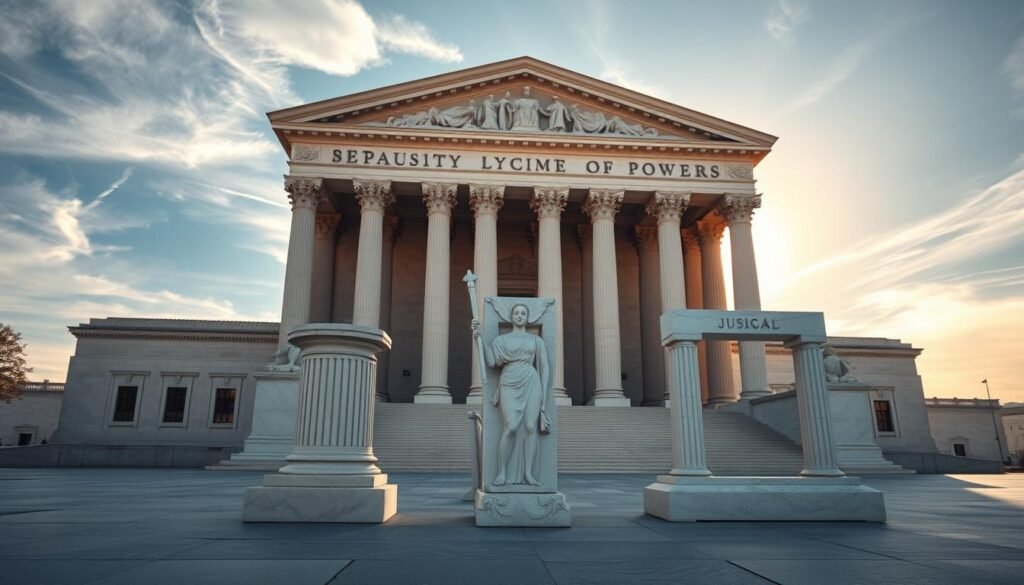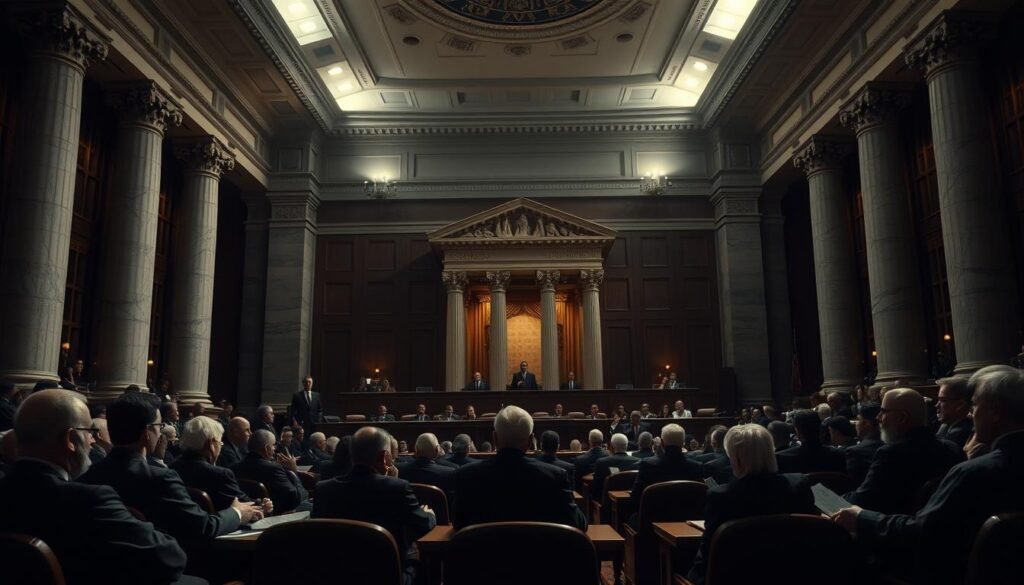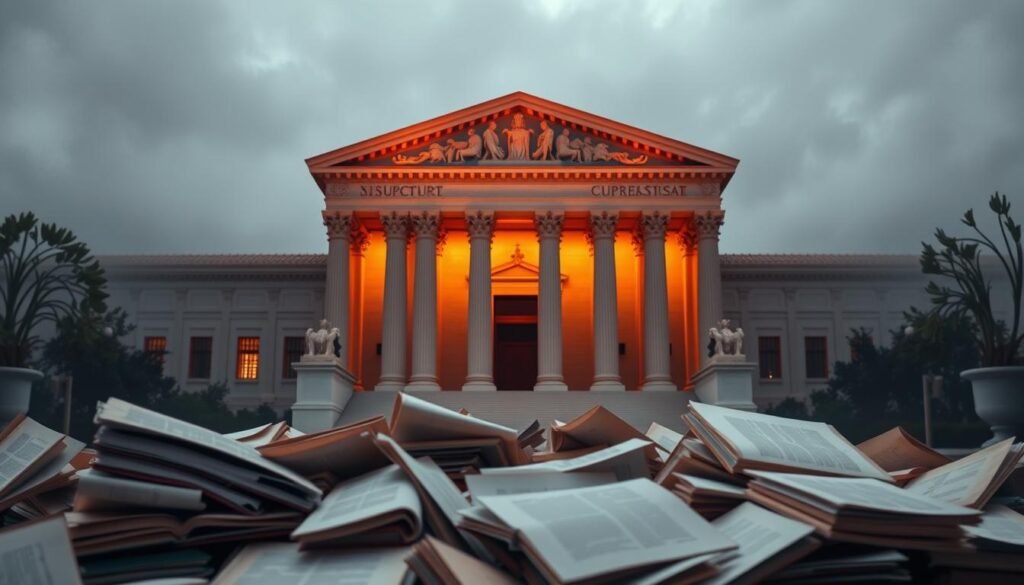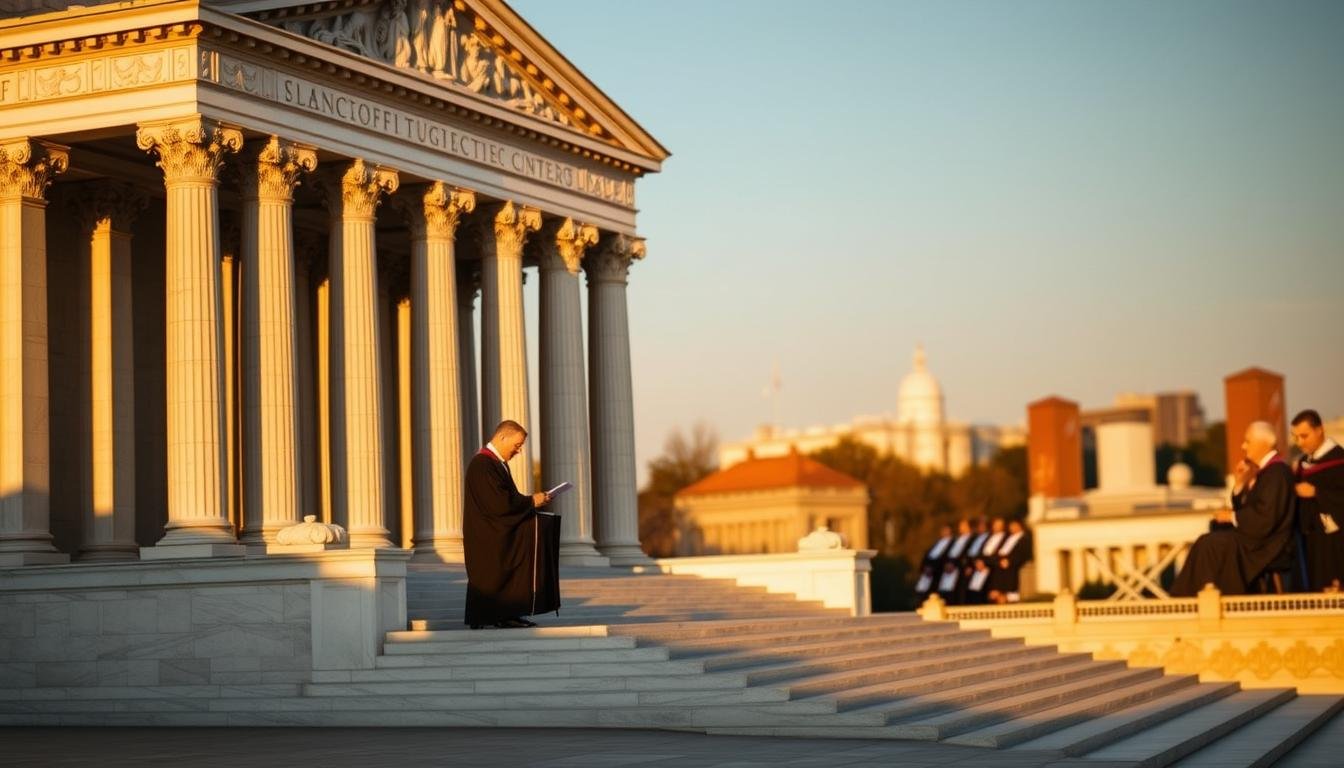Can one court truly decide whether a statute stands or falls for the whole nation?
This article explains how the power to test statutes against the Constitution became central to American governance. It traces the path from early cases like Hylton v. United States (1796) to the defining moment in Marbury v. Madison (1803), where Chief Justice John Marshall framed the role of the supreme court.
Readers will learn why Article III jurisdiction and Article VI’s supremacy and oath clauses imply this authority. The piece also gives a sense of scale: the Court has struck down many congressional acts over time, and lower courts feed issues upward for final resolution.
Practical stakes are high for citizens, lawyers, and government officials who must navigate constitutional limits. For background on early precedent and a government overview, see this official primer on review and a detailed account of Marbury v. Madison.
Key Takeaways
- Judicial review lets courts test laws against the Constitution and invalidate conflicts.
- Hylton (1796) and Marbury (1803) anchored the practice early in U.S. history.
- Article III and Article VI provide the structural basis for this power.
- The supreme court has repeatedly used this authority to shape national policy.
- Understanding review helps citizens and policymakers navigate constitutional limits.
Understanding Judicial Review In U.S. Law
What This Concept Means Today
At its core, the power to assess laws for constitutionality keeps the national legal order coherent. Courts answer claims that statutes, regulations, or executive actions conflict with the U.S. Constitution. When a conflict exists, a court can render the measure unenforceable.
What Judicial Review Is And Why It Matters
The doctrine rests on Article III’s grant of cases “arising under” the Constitution and Article VI’s Supremacy Clause plus the judicial oath. Together they imply a duty for judges to prefer constitutional commands over ordinary statutes.
Present-Day Relevance For Citizens, Lawyers, And Policymakers
Procedurally, parties raise constitutional claims, courts analyze text, history, and precedent, and decisions may reach the supreme court by appeal.
This power shapes civil rights, administrative actions, criminal procedure, and federalism disputes. It checks overreach, clarifies authority, and forces governments to adjust policy when a decision recalibrates nationwide enforcement.
“An authoritative interpreter prevents fragmentation of constitutional meaning across the United States.”
- Defines scope: statutes, executive actions, regulations.
- Limits: justiciability doctrines, standards of review, institutional restraint.
Origins Before The Constitution
Early practice in the states supplied practical grounding for later national doctrine.
Early state decisions show judges striking down statutes that clashed with their state constitutions. Courts in several jurisdictions treated written charters as the rule that trumped ordinary enactments. Those local rulings made the idea of a judicial duty to enforce higher law familiar by the time delegates met in 1787.
State Court Precedents: Bayard v. Singleton And Commonwealth v. Caton
Commonwealth v. Caton (1782) stands out because George Wythe urged judges to look to the constitution as the limit on legislative power. Bayard v. Singleton (1787) is one of the first reported examples where a court declined to enforce a statute that violated a state charter.
Ideas In The Founding Era: George Wythe And Alexander Hamilton
Wythe’s practical rulings and Alexander Hamilton’s argument in Federalist No. 78 both advanced the view that courts must prefer constitutional commands to ordinary statutes. Those voices helped shape how delegates and ratifiers understood the role of courts.
Transatlantic Roots And Debates Over Dr. Bonham’s Case
Legal thinkers also debated older English precedents such as Dr. Bonham’s Case. Some historians see those transatlantic arguments as an antecedent that validated the notion that a court could set aside unjust or unlawful statutes.
“State precedents gave the fledgling republic concrete examples of courts policing constitutional limits.”
- Multiple states—New Jersey, Rhode Island, New York, North Carolina, and Virginia—offered early instances of review.
- Press coverage and debate made these practices part of public understanding before ratification.
Constitutional Foundations: Articles III And VI
Article III and Article VI together create the structural basis for courts to apply constitutional commands when statutes conflict with higher law.
The Judicial Power And Cases Arising Under The Constitution
Article III vests the judicial power in one Supreme Court and extends it to cases arising under the constitution, federal statutes, and treaties. This grant gives federal tribunals the authority to decide disputes that require interpreting the text and meaning of the charter.
The practical effect is that judges must identify the controlling rule of law when a claim turns on constitutional text. That duty supplies the institutional basis for judicial review and for resolving conflicts between statutes and higher commands.
The Supremacy Clause And The Oath To Uphold The Constitution
Article VI declares the document and laws made pursuant to it the supreme law of the land. Judges take an oath to uphold the constitution, which requires preferring the charter over inconsistent enactments.
This reach covers federal and state actors, creating uniformity across the United States and preventing a patchwork of contradictory state measures.
Why Judicial Review Is Implied Rather Than Explicit
The text does not spell out a separate power to set statutes aside. Yet Framers such as James Madison and commentators like Hamilton in Federalist No. 78 treated unconstitutional acts as void. That necessary implication flows from the courts’ duty to decide cases by applying controlling law.
“When a statute conflicts with the constitution, a judge must follow the constitution.”
John Marshall later crystallized this logic in Marbury Madison, tying the constitutional scheme to a recognizable judicial decision-making role. Later sections trace how Hylton and Marbury formalized the practice and how the power judicial evolved across time.
For a concise historical overview, see this constitutional law overview.
What The Framers And Ratifiers Said
Framers and ratifiers treated judicial review as an expected check within the constitutional design. Delegates debated a “council of revision” but rejected it partly because judges already acted to set aside invalid statutes.
Convention Debates: The Council Of Revision And Judicial Checks
Speakers like Elbridge Gerry and Luther Martin noted that judges had long refused to enforce laws that violated higher rules. James Madison said unconstitutional acts would be null and void.
State Ratification Conventions And Public Understanding
At ratifying conventions, James Wilson and Oliver Ellsworth explained that courts would treat ultra vires federal acts as void. That view helped shape public expectations of the new government.
The Federalist Papers: No. 78, No. 80, And No. 82
Federalist No. 78 argued judges must prefer the constitution over conflicting statutes. Nos. 80 and 82 stressed national uniformity and appellate authority for the supreme court authority.
“If a written constitution is to mean anything, judges must enforce it against contrary laws.”
- Delegates rejected extra review bodies because courts already served that check.
- Ratifiers confirmed the judiciary’s interpretive powers while urging restraint.
- Anti-Federalist warnings, like Brutus, forecast tensions over expansive courts.
Early Federal Practice: The Judiciary Act Of 1789 And Hylton v. United States
The early federal judiciary set procedural paths that let constitutional questions move from state benches to the nation’s highest court.
The Judiciary Act of 1789 established district and circuit courts and created appeals that could reach the supreme court. Section 25 specifically allowed appellate review of state judgments that touched federal issues.
Section 25 And Supreme Court Review Of State Judgments
Section 25 let the supreme court correct state rulings that invalidated federal statutes or upheld state measures against federal claims. This mechanism promoted uniform interpretation across the united states and strengthened court authority over conflicting state decisions.
Hylton’s Confirmation Of Constitutional Adjudication
In Hylton v. United States (1796) the court treated a carriage tax challenge as a proper case for assessment and upheld the statute. Though the outcome favored Congress, the opinion showed that courts would assess the constitutionality of Acts of Congress on the merits.
| Feature | Effect | Example |
|---|---|---|
| Section 25 | Appellate path from state courts | Allowed review state judgments |
| National Uniformity | Consistent federal interpretation | Supreme court oversight |
| Early Case Law | Created precedents for assessment | Hylton v. United States |
“Early statutes and cases embedded the practice that later found full expression in Marbury Madison.”
Marbury v. Madison: The Case That Defined The Power
Marbury v. Madison transformed a private dispute over a commission into a national rule about the court’s role. The opinion balanced firm legal reasoning with institutional caution.

Chief Justice John Marshall’s Reasoning And Article VI
John Marshall held that the Constitution is the supreme standard and that judges must apply it when statutes conflict. He explained that the Article VI oath gives judges a duty to prefer the Constitution over ordinary acts of Congress.
Limits, Remedies, And The Assertion Of Judicial Authority
The Court found a provision of the Judiciary Act of 1789 that granted original mandamus power at odds with Article III. Marshall declared that Congress cannot expand the Court’s original jurisdiction and that such a statute is void.
The ruling both asserted the power of judicial review and refused an improper remedy. William Marbury did not receive his commission, yet the decision firmly established the supreme court as the ultimate constitutional interpreter.
| Issue | Holding | Effect |
|---|---|---|
| Original Jurisdiction for Mandamus | Provision void under Article III | Limits congressional expansion of jurisdiction |
| Role of Judges | Oath requires following Constitution | Courts may declare a statute unconstitutional |
| Immediate Outcome | No commission for Marbury | Institutional authority strengthened |
For the original text and context, see Marbury v. Madison.
The Scope Of Judicial Review Over State And Federal Actions
The national courts serve to harmonize disputes between state acts and federal authority so the country speaks with one legal voice.
Reviewing State Constitutions, Statutes, And Actions
Article VI makes the Constitution and valid federal laws the supreme law of the land, so courts must disregard conflicting state constitutions and statutes.
The supreme court’s appellate power over state courts secures uniformity. That power prevents a patchwork of state-by-state outcomes and makes finality possible for important constitutional claims.
Reviewing Acts Of Congress And Executive Actions
The court also assesses federal statutes and executive action to ensure they fit the charter and statutory limits.
These reviews are often more contested and invoke doctrines of restraint. The court decides whether a statute is “in pursuance” of constitutional authority and whether an executive action exceeds statutory grant.
Uniformity, Finality, And The Court Of Last Resort
The court acts as the court of last resort for constitutional disputes. It issues binding remedies—injunctions and declaratory judgments—that guide officials and lower courts.
“When federal and state law collide, a single authoritative decision preserves nationwide predictability.”
| Scope | Focus | Practical Effect |
|---|---|---|
| State Measures | Preemption; conflicts with state constitutions | Uniform federal standard; state laws displaced |
| Federal Statutes | Constitutional text; powers granted to Congress | Limits on congressional authority; doctrine clarified |
| Executive Actions | Statutory compliance; separation of powers | Checks on executive reach; guidance for agencies |
Separation Of Powers, Federalism, And The Rule Of Law
The framers conceived a system that balances authority across branches while preserving state autonomy.
The design uses neutral tribunals to check excesses by elected actors. When a branch exceeds its grant of power, the court can declare the action void and restore equilibrium.

Checks And Balances In Practice
The mechanism functions through principled opinions, not force. The judiciary has neither the purse nor the sword, so it relies on reasoned rulings and public legitimacy to secure compliance.
Examples: Cases that police delegations, appointments, and removal sharpen institutional boundaries. Those decisions show how review protects the separation of powers and supports predictable governance.
Maintaining National Uniformity While Respecting States
At the same time, the system preserves federalism. States keep broad police authority, but that authority must conform to the national constitution.
| Function | Effect | Illustration |
|---|---|---|
| Checks Between Branches | Limits overreach | Invalidates ultra vires acts |
| Federalism Guardrails | State autonomy within bounds | State policies tested against constitution |
| Rule Of Law | Predictable standards | Stare decisis stabilizes doctrine |
“Contested issues are settled at every level through adjudication, preserving national unity while honoring state choice.”
Judicial Activism, Restraint, And Standards Of Review
How courts choose when to intervene shapes the scope of constitutional protection and institutional trust.
Court decision-making alternates between activism and restraint depending on era and issue. Both liberal and conservative justices have acted boldly or deferred, based on subject matter and context.
When Courts Intervene And When They Hold Back
Justiciability doctrines—standing, ripeness, mootness, and political questions—filter cases and keep courts from answering every dispute.
Those limits reduce unnecessary clashes with other branches and preserve judicial resources. They also shape when a controversial decision reaches the supreme court.
Tiers Of Scrutiny And Doctrinal Tools
Courts apply tiers of scrutiny—rational basis, intermediate scrutiny, and strict scrutiny—to guide outcomes on equal protection and fundamental rights.
Other tools, like the canon of constitutional avoidance and severability, let courts resolve defects while preserving valid parts of statutes.
“Principled standards make controversial power more predictable and defendable.”
- Standards channel discretion and improve transparency for litigants and lawmakers.
- Stare decisis tempers abrupt shifts but allows overruling when precedent is unworkable.
- Different standards yield distinct results across speech, equal protection, and economic regulation.
Ultimately, articulated tests and doctrines help courts sustain legitimacy even when their decisions provoke debate.
From Economic Regulation To Civil Rights
The nation’s constitutional focus shifted sharply from protecting business liberty to enforcing individual rights and equality.

The Court once relied on substantive due process and the Contract Clause to strike down many economic regulations. This emphasis on liberty of contract drew fierce critique for substituting judges’ policy views for legislative judgment.
During the New Deal, the bench retreated. Judges began deferring to broad economic and social legislation under rational basis review. That change granted government new latitude to address economic crises.
Rise Of Individual Rights And Equal Protection Review
From mid‑20th century, courts turned to civil liberties and civil rights. The Court embraced stronger protections for speech, voting, and personal freedoms. Equal protection doctrine introduced heightened scrutiny for suspect classifications.
Effect: Rights-centered review reshaped state and local policy on education, policing, and voting. Strict scrutiny often proved fatal to laws that burdened fundamental rights or targeted protected groups.
- Lochner-era emphasis: liberty of contract and property.
- Post-New Deal: deference to economic regulation.
- Modern focus: individual rights, equality, and robust review of discriminatory laws.
For background on that period, see a concise Lochner era overview.
Due Process, Incorporation, And The Fourteenth Amendment
The Fourteenth Amendment altered the reach of federal protections by making many national guarantees apply to state governments. This change forced courts to draw lines between fair procedure and protected liberties.
Procedural Versus Substantive Due Process
Procedural due process demands fair notice and a hearing before the government deprives a person of life, liberty, or property.
Substantive due process protects certain core liberties from government interference, even when procedures exist.
“Distinguishing process from protected liberty frames many modern rights disputes.”
Total Versus Selective Incorporation Of The Bill Of Rights
The Court rejected wholesale adoption of the Bill of Rights against the states. Instead, it used selective incorporation to apply those guarantees deemed fundamental to ordered liberty.
- Selective approach brought many criminal procedure and speech protections into state courts.
- The process relied on a case-by-case assessment of constitutional value.
- The power judicial to enforce these rulings created a uniform baseline across the United States.
| Aspect | Focus | Effect |
|---|---|---|
| Procedural Due Process | Fair hearings and notice | Guards against arbitrary state action |
| Substantive Due Process | Protected liberties | Limits state power over personal rights |
| Selective Incorporation | Fundamental guarantees | Applies federal rights to state law |
For a concise primer on due process doctrine, see the linked resource.
Modern Flashpoints: Roe, Dobbs, And The Current Court
Recent case law has pushed core questions about rights, precedent, and institutional role to the forefront. The Court’s choices have had immediate and wide effects across the united states.

Roe v. Wade And The Expansion Of Judicial Review
Roe v. Wade (1973) located abortion rights within substantive due process. The decision used a trimester framework and marked broad court involvement with a heated policy area.
Dobbs v. Jackson And The Recalibration Of Rights
Dobbs (2022) overturned Roe and held the Constitution does not mention abortion, returning regulation to state legislatures. That ruling produced a patchwork of statutes, litigation over trigger bans, and questions about exceptions and enforcement.
Public Legitimacy And The Pace Of Doctrinal Change
Observers debate how rapid doctrinal shifts affect the Court’s credibility. Critics say swift reversal harms reliance and trust. Supporters argue textual and historical methods restore democratic choice.
“The Court’s decisions shape which rights the country protects and how government must respond.”
Practitioners advise caution as lower tribunals navigate evolving precedent. For deeper historical analysis, consult this scholarly account.
Nondelegation, Administrative Power, And Vague Statutes
Modern disputes test whether broad grants of authority to regulators upset the constitutional balance among branches. The topic ties history and present concerns about how much policy-making power Congress may cede.
New Deal Conflicts And The Court-Packing Crisis
In the 1930s the supreme court struck down several New Deal statutes for conceding too much legislative power to agencies.
Those decisions sparked a political fight that culminated in President Roosevelt’s court-packing proposal. The clash reshaped how courts approached delegation going forward.
Contemporary Debates Over Agency Authority
After retreating from strict nondelegation enforcement, courts allowed broad administrative discretion. That shift let agencies run complex regulatory programs across the government.
Still, courts use review to police vague statutes under the void-for-vagueness doctrine. Due process requires fair notice and limits arbitrary enforcement.
“Separation-of-powers principles remain central to evaluating delegations and executive enforcement discretion.”
- Major questions and deference doctrines shape how much agencies can act without fresh congressional direction.
- Standards of review calibrate agency latitude while protecting constitutional structure.
- Renewed interest in nondelegation could force clearer statutory drafting and tighter oversight.
Measuring Impact: Laws Struck Down And Trends Over Time
Quantifying how often courts nullify statutes helps show the real impact of constitutional oversight.

Snapshot: As of 2014, the supreme court held 176 Acts of Congress unconstitutional. From 1960 to 2019, the Court invalidated 483 laws in whole or in part.
Acts Of Congress And State Laws Held Unconstitutional
Invalidations of federal statutes are relatively rare. The bench shows institutional caution before striking Acts of Congress.
By contrast, courts have voided thousands of state provisions over time. That pattern reflects broad state powers and extensive incorporation under the Fourteenth Amendment.
Patterns From 1960 To The Present
Post‑1960 trends show heightened rights enforcement and evolving administrative doctrine shaping outcomes.
Doctrinal shifts—changes in scrutiny levels or federalism tests—alter which statutes fall and where litigation concentrates.
- Quantitative snapshots help lawmakers and agencies anticipate constitutional challenges.
- Severability and narrowing constructions often limit the real-world effect of a decision.
- Lower courts and en banc review build records that the supreme court relies on before major rulings.
“Numbers matter, but they must be read with care—context, doctrine, and institutional posture explain much of the variation.”
The data guides practical planning for the united states’ legislators and litigants. It also shapes how future statutes get drafted to avoid clear constitutional defects.
Global Perspective: How U.S. Judicial Review Influenced The World
After World War II, several nations adopted written charters and courts to protect them. New constitutional courts in Europe and Asia took on power to set aside laws that conflicted with higher texts. That shift reflected a broader turn toward legal checks as part of democratic rebuilding.
Constitutional Courts Abroad After World War II
Germany, Japan, and Italy created specialized constitutional tribunals that could invalidate statutes. France, Ireland, and Israel followed with analogous institutions. Post‑Soviet states later embraced charters and court authority to bolster the rule of law.
European Union And Human Rights Courts
The European Court of Justice ensures uniform interpretation of EU treaties, while the European Court of Human Rights monitors member states’ compliance with human rights standards.
“A court of last resort for constitutional questions enhances rule‑of‑law commitments and minority protections.”
| Institution | Role | Effect |
|---|---|---|
| Constitutional Court | Invalidate inconsistent statutes | Strengthens rights |
| ECJ | Interpret EU law | Uniform application |
| ECHR | Supranational oversight | State accountability |
Takeaway: The united states’ example helped popularize a mechanism to reconcile democratic acts with higher‑law constraints. Different institutional designs shape how review affects governance, separation of powers, and public legitimacy at every level.
Conclusion
,What began as scattered state practice and theoretical argument matured into a national mechanism for enforcing constitutional limits.
Judicial review emerged from Articles III and VI, early cases like Hylton, and the defining Marbury doctrine. It has invalidated hundreds of statutes and shaped how the supreme court resolves major questions about power and rights.
The balance between intervention and restraint matters. Courts use standards of review, justiciability, and precedent to decide when to act. That care keeps the system credible while protecting liberties across the united states.
For a concise historical summary, see this history of judicial review. Understanding the power judicial review helps citizens, lawmakers, and practitioners navigate constitutional limits and reduce needless litigation.
